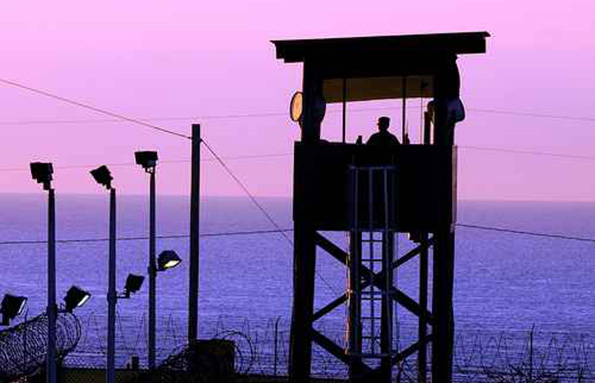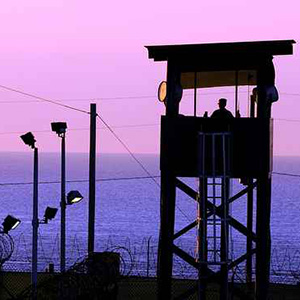
Dr Michelle Farrell is a Senior Lecturer in Law in the School of Law and Social Justice and Co-Director of the International Law and Human Rights Unit. She is currently an O’ Brien Fellow in Residence at the Centre for Human Rights and Legal Pluralism, University of McGill.
On 22 January 2009, his second day in office, President Barack Obama issued an Executive Order to promptly “close detention facilities at Guantánamo, consistent with the national security and foreign policy interests of the United States and the interests of justice”. His self-imposed deadline for closure was 22 January 2010. This week, over 7 years later, Obama sent his last-ditch plan at closing the detention facility to Congress. The plan outlines a vague approach to dealing with the remaining 91 detainees at the facility.
These 91 individuals fall in to three different categories under the Obama plan. 35 individuals – most of whom have long been deemed to pose no threat whatsoever – are eligible for transfer to their home country or a third country, should the former prove impossible. These individuals have remained in detention for years despite their innocence. That leaves 56 individuals. 10 of these are at various stages of the controversial process of (unfair) trial by military commission. In addition, a number of individuals have been identified as “subject to prosecution or conviction by military commission” or to prosecution by domestic US courts; others, subject to review, are also potentially eligible for transfer abroad.
A final category of well over 30 individuals remain in limbo, in indefinite detention. These individuals are, for the most part, considered a threat, or too dangerous for release, yet they cannot be prosecuted. They cannot be prosecuted for various reasons – there is not enough evidence against them or the evidence is tainted by torture – the so-called fruit of the poisoned tree. These reasons undermine the case against them in the first place. Under the Obama plan, these individuals would be transferred to US detention facilities, for continued indefinite detention.
Obama’s plan is skeletal. The general scheme seems to rest on closing Guantánamo and getting the 91 either transferred to a willing country or in to the United States for detention or trial. However, Obama has failed to avert the legal and practical barriers that his plan will meet in Congress. Even though the transfer plans are underfoot, there is little clarity in the document on dates or practicalities. More importantly, at least for the success of the controversial US-based part of the plan, he has not specified detention facilities that may hold these individuals, whether convicted or in indefinite detention. Uncertainty also prevails in his account of where military commissions might be located and in which federal courts outstanding cases might be heard. His plan has been greeted with scepticism so far. There is nothing new here, it would seem, that will overcome previous impediments to closure. Since 2009, Congress has repeatedly showed no appetite for the transfer of detainees to US soil.
Obama’s years in office have been burdened by this inheritance left to him by George W. Bush. Obama has also certainly been frustrated by the tough politics surrounding the closure of Guantanamo. His speech and the plan indicate this frustration:
“For many years, it has been clear that the detention facility at Guantanamo Bay does not advance our national security—it undermines it…It’s counterproductive to our fight against terrorists, because they use it as propaganda in their efforts to recruit. It drains military resources, with nearly $450 million spent last year alone to keep it running… Guantanamo harms our partnerships with allies and other countries whose cooperation we need against terrorism. When I talk to other world leaders they bring up the fact that Guantanamo is not resolved. Moreover, keeping this facility open is contrary to our values.”
Never acted in principle against the facility
He can list countless reasons for closure. The plight of these individuals is noticeably not amongst them, however. This is hardly a surprise. Public support for closure is low as is public sympathy for the individuals held there; the public view of the detainees remains framed in the language initially imposed by Bush in the aftermath of 11 September. Indeed Obama’s own counter-terrorism practices place him in a difficult position to call out his predecessor. At any rate, for his part, Obama may have a principled stance against Guantanamo based on national security, on the reputation of the United States internationally and on that classically liberal (and useful) catch-all – “our values” –he has, however, never acted in principle against the facility nor has he admitted to what it is that makes Guantánamo “contrary to our values”.
The 91 are not viewed as humans, certainly not as rights bearers; they are terrorists and a threat or, at best, detainees and numbers. They are guilty until proven innocent. Their treatment in detention has been notorious. From Obama, there has been no mention of the torture and ill-treatment to which many of them have been subjected. There has been no mention of the inhuman and degrading conditions of detention in which they have been kept. There has been no mention of their force-feeding. The 91 are so far outside the frame of Obama’s perception that there remains no plan to prevent the continued indefinite detention of most of them. Obama wants the facility closed. The practices it has facilitated, and continues to facilitate, however, he seems to care less about.
